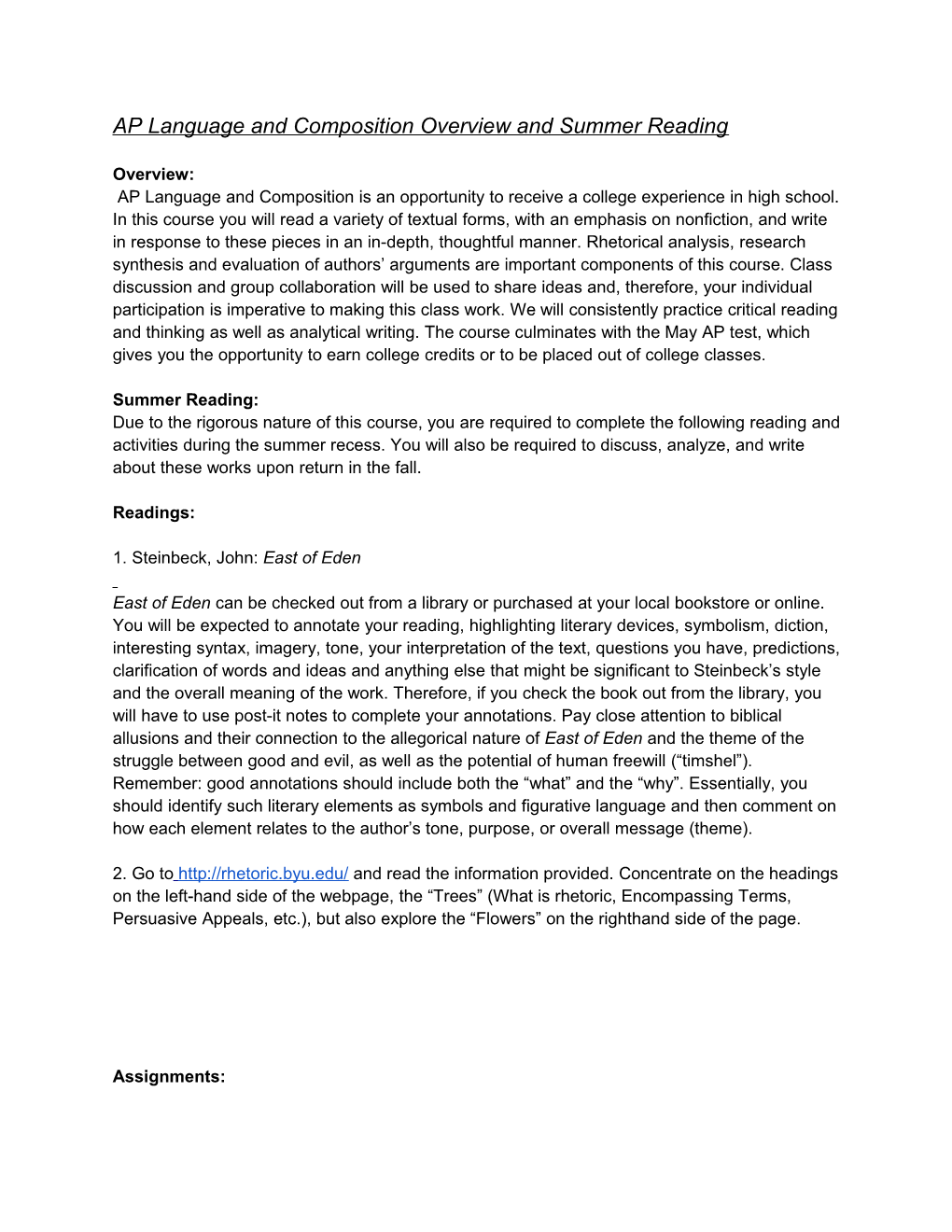AP Language and Composition Overview and Summer Reading
Overview:
AP Language and Composition is an opportunity to receive a college experience in high school. In this course you will read a variety of textual forms, with an emphasis on nonfiction, and write in response to these pieces in an in-depth, thoughtful manner. Rhetorical analysis, research synthesis and evaluation of authors’ arguments are important components of this course. Class discussion and group collaboration will be used to share ideas and, therefore, your individual participation is imperative to making this class work. We will consistently practice critical reading and thinking as well as analytical writing. The course culminates with the May AP test, which gives you the opportunity to earn college credits or to be placed out of college classes.
Summer Reading:
Due to the rigorous nature of this course, you are required to complete the following reading and activities during the summer recess. You will also be required to discuss, analyze, and write about these works upon return in the fall.
Readings:
1. Steinbeck, John: East of Eden
East of Eden can be checked out from a library or purchased at your local bookstore or online. You will be expected to annotate your reading, highlighting literary devices, symbolism, diction, interesting syntax, imagery, tone, your interpretation of the text, questions you have, predictions, clarification of words and ideas and anything else that might be significant to Steinbeck’s style and the overall meaning of the work. Therefore, if you check the book out from the library, you will have to use post-it notes to complete your annotations. Pay close attention to biblical allusions and their connection to the allegorical nature of East of Eden and the theme of the struggle between good and evil, as well as the potential of human freewill (“timshel”). Remember: good annotations should include both the “what” and the “why”. Essentially, you should identify such literary elements as symbols and figurative language and then comment on how each element relates to the author’s tone, purpose, or overall message (theme).
2. Go to and read the information provided. Concentrate on the headings on the left-hand side of the webpage, the “Trees” (What is rhetoric, Encompassing Terms, Persuasive Appeals, etc.), but also explore the “Flowers” on the righthand side of the page.
Assignments:
Annotate the novel and be ready to write an essay, take an objective test, complete a project, and/or conduct a scored discussion on the themes and literary elements of the novel during the first week of school. Your annotations will be essential to completing these assignments.
Read the information on the Silva Rhetoricae webpage. Use the study guide to take notes on what you learn from the website. Be ready to take a test on this information during the first week of school.
If you have any questions, please see Ms. Rose in room 204 or e-mail @ <
The Forest of Rhetoric Study Guide
- Throughout the ages, rhetoric has been a discipline which trains students in which two fundamental skills?
- Explain the difference between form and content.
- The concept of kairos is closely linked to what two other considerations?
- Define decorum.
- List two rhetorical vices.
- Explain stasis and list two types of stasis.
- What are the three rhetorical appeals? Which appeal was preferred by Aristotle?
- What makes a syllogism a “figure of reasoning” or appeal to logos?
- Read the “figures of pathos”. Are any familiar to you? List them.
- Explain ethos.
- List the three branches of oratory and explain their differing functions.
- Which two canons of rhetoric have received the least attention?
- List some of the “common” topics of invention.
- What is the arrangement of classical oration? According to Cicero, how do the three appeals relate to the different parts of classical arrangement ?
- List the virtues of style.
- List the three levels of style and their respective purposes.
- What is the difference between figures of speech and figures of thought?
- What is the difference between rhetorical schemes and rhetorical tropes?
- Explore the rhetorical figures on the right-hand side of the page. Find three figures with wacky names and write the following:
- definition
- example
- related figures
20. What is the Greek word for delivery?
21. What are the three areas of rhetorical ability that Cicero’s characters debate?
22. Fill in the blanks: Rhetorical pedagogy relied upon a very close relationship between ______and______, ______and______.
23. Explain what progymnasmata or declamations are. What was their purpose? Where and how were they used? List them
24. Who wrote the Ad Herennium? During what time period did Erasmus write about rhetoric?
Feel free to further explore the “flowers” of rhetoric on the right-hand side of the webpage. These will become important during the school year. Hope you learned something!!!
